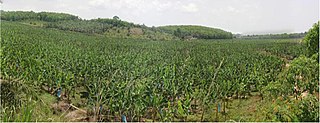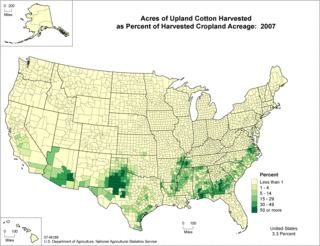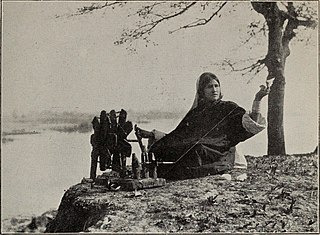Related Research Articles

Cotton is a soft, fluffy staple fiber that grows in a boll, or protective case, around the seeds of the cotton plants of the genus Gossypium in the mallow family Malvaceae. The fiber is almost pure cellulose, and can contain minor percentages of waxes, fats, pectins, and water. Under natural conditions, the cotton bolls will increase the dispersal of the seeds.

A cotton gin—meaning "cotton engine"—is a machine that quickly and easily separates cotton fibers from their seeds, enabling much greater productivity than manual cotton separation. The fibers are then processed into various cotton goods such as calico, while any undamaged cotton is used largely for textiles like clothing. The separated seeds may be used to grow more cotton or to produce cottonseed oil.

A plantation is an agricultural estate, generally centered on a plantation house, meant for farming that specializes in cash crops, usually mainly planted with a single crop, with perhaps ancillary areas for vegetables for eating and so on. The crops that are grown include cotton, cannabis, coffee, tea, cocoa, sugar cane, opium, sisal, oil seeds, oil palms, fruits, rubber trees and forest trees. Protectionist policies and natural comparative advantage have sometimes contributed to determining where plantations are located.
The history of agriculture in the United States covers the period from the first English settlers to the present day. In Colonial America, agriculture was the primary livelihood for 90% of the population, and most towns were shipping points for the export of agricultural products. Most farms were geared toward subsistence production for family use. The rapid growth of population and the expansion of the frontier opened up large numbers of new farms, and clearing the land was a major preoccupation of farmers. After 1800, cotton became the chief crop in southern plantations, and the chief American export. After 1840, industrialization and urbanization opened up lucrative domestic markets. The number of farms grew from 1.4 million in 1850, to 4.0 million in 1880, and 6.4 million in 1910; then started to fall, dropping to 5.6 million in 1950 and 2.2 million in 2008.
A plantation economy is an economy based on agricultural mass production, usually of a few commodity crops, grown on large farms worked by laborers or slaves. The properties are called plantations. Plantation economies rely on the export of cash crops as a source of income. Prominent crops included cotton, rubber, sugar cane, tobacco, figs, rice, kapok, sisal, and species in the genus Indigofera, used to produce indigo dye.
Teseney, also spelled Tessenei or Tesseney, is a market town in western Eritrea. It lies south-east of Kassala in Sudan, on the Gash River. The city was much fought over in the Eritrean War of Independence during which much of it was destroyed. After the war, Tessenei has become a governmental administrative center with customs and agricultural offices and a military base.

The Gezira Scheme is one of the largest irrigation projects in the world. It is centered on the Sudanese state of Al Jazirah, just southeast of the confluence of the Blue and White Nile rivers at the city of Khartoum. The Gezira Scheme was begun by the British while the area was governed as part of Anglo-Egyptian Sudan. Water from the Blue Nile is distributed through canals and ditches to tenant farms lying between the Blue and White Nile rivers.

Gossypium barbadense is one of several species of cotton. It is in the mallow family. It has been cultivated since antiquity, but has been especially prized since a form with particularly long fibers was developed in the 1800s. Other names associated with this species include Sea Island, Egyptian, Pima, and extra-long staple (ELS) cotton.

Agriculture was the foundation of the economy in Ivory Coast and its main source of growth. In 1987 the agricultural sector contributed 35 percent of the country's GDP and 66 percent of its export revenues, provided employment for about two-thirds of the national work force, and generated substantial revenues despite the drop in coffee and cocoa prices. From 1965 to 1980, agricultural GDP grew by an average 4.6 percent per year. Growth of agricultural GDP from coffee, cocoa, and timber production, which totaled nearly 50 percent of Ivory Coast's export revenues, averaged 7 percent a year from 1965 to 1980.

Agriculture in Sudan plays an important role in that country's economy. Agriculture and livestock raising are the main sources of livelihood for most of the Sudanese population. It was estimated that, as of 2011, 80 percent of the labor force were employed in that sector, including 84 percent of the women and 64 percent of the men.

The role of agriculture in the Bolivian economy in the late 1980s expanded as the collapse of the tin industry forced the country to diversify its productive and export base. Agricultural production as a share of GDP was approximately 23 percent in 1987, compared with 30 percent in 1960 and a low of just under 17 percent in 1979. The recession of the 1980s, along with unfavorable weather conditions, particularly droughts and floods, hampered output. Agriculture employed about 46 percent of the country's labor force in 1987. Most production, with the exception of coca, focused on the domestic market and self-sufficiency in food. Agricultural exports accounted for only about 15 percent of total exports in the late 1980s, depending on weather conditions and commodity prices for agricultural goods, hydrocarbons, and minerals.

Historically, cotton production in Azerbaijan has been crucial to the national economy, accounting for approximately 25% of agricultural revenue. It occurs mainly in the area west of the Caspian Sea. Historical records supported by archaeological excavations have established cotton growing in Azerbaijan to the 5th and 6th centuries AD. During the Soviet era, it was termed as the nation's "white gold". Since the fall of the Soviet Union and independence, cotton has significantly declined in output, given that oil and grains are more profitable for Azeri farmers.
The British Central Africa Company Ltd was one of the four largest European-owned companies that operated in colonial Nyasaland, now Malawi. The company was incorporated in 1902 to acquire the business interests that Eugene Sharrer, an early settler and entrepreneur, had developed in the British Central Africa Protectorate. Sharrer became the majority shareholder of the company on its foundation. The company initially had trading and transport interests, but these were sold by the 1930s. For most of the colonial period, its extensive estates produced cotton, tobacco or tea but the British Central Africa Company Ltd developed the reputation of being a harsh and exploitative landlord whose relations with its tenants were poor. In 1962, shortly before independence, the company sold most of its undeveloped land to the Nyasaland government, but it retained some plantations and two tea factories. It changed its name to The Central Africa Company Ltd and was acquired by the Lonrho group, both in 1964.

The United States exports more cotton than any other country, though it ranks third in total production, behind China and India. Almost all of the cotton fiber growth and production occurs in the Southern United States and the Western United States, dominated by Texas, California, Arizona, Mississippi, Arkansas, and Louisiana. More than 99 percent of the cotton grown in the US is of the Upland variety, with the rest being American Pima. Cotton production is a $21 billion-per-year industry in the United States, employing over 125,000 people in total, as against growth of forty billion pounds a year from 77 million acres of land covering more than eighty countries. The final estimate of U.S. cotton production in 2012 was 17.31 million sales, with the corresponding figures for China and India being 35 million and 26.5 million bales, respectively. Cotton supports the global textile mills market and the global apparel manufacturing market that produces garments for wide use, which were valued at USD 748 billion and 786 billion, respectively, in 2016. Furthermore, cotton supports a USD 3 trillion global fashion industry, which includes clothes with unique designs from reputed brands, with global clothing exports valued at USD 1.3 trillion in 2016.
Cotton is an important crop to the economy of Chad.

Telangana is one of the fastest-growing states in India posing average annual growth rate of 13.90% over the last five years. Telangana's nominal gross state domestic product for the year 2020-21 stands at ₹13.59 lakh crore. Service sector is the largest contributor to the Telangana's economy with a share of about 65% in the year 2018-19. Growth in services has largely been fuelled by IT services with the State holding leading position in IT & ITeS in the country in terms of production and exports.

Cotton production in Pakistan is integral to the economic development of the country. The nation is largely dependent on the cotton industry and its related textile sector, and the crop has been given a principal status in the country. Cotton is grown as an industrial crop in 15% of the nation's land during the monsoon months of May to August, known as the Kharif period, and is grown at a smaller scale between February and April.Pakistan occupied the fourth position among the cotton growers of the world, the first three bgehhrhrhrui bfhejirjrjdhruirjrkeiro htjdlcnc. Xbz.
Cotton in Malawi is an important part of the agricultural history of Malawi. Cotton is not indigenous to the country, but was introduced into warmer lowland areas no later than the 17th century. Production in the late pre-colonial and early colonial period was limited but, from the early 20th century, it has been grown mainly by African smallholders in the south of the country. For a brief period during the First World War, cotton was the most valuable export crop, and it has remained an important earner of foreign exchange.
The economic de-industrialisation of India refers a period of reduction in industrial based activities within the Indian economy from 1757 to 1947. The process of de-industrialisation is an economic change in which employment in the manufacturing sector declines due to various economic or political reasons. The decline in employment in manufacturing is also followed by the fall in the share of manufacturing value added in GDP. The process of de-industrialisation can be due to development and growth in the economy and it can also occur due to political factors. In other words, the term de-industrialisation means a general reduction in the industrial capacity and came into prevalence in India with the decline and collapse of the handicrafts industry by external competition from British-manufactured products during the 19th century.
Sudan had a modern irrigated agriculture sector totaling about 800,000 hectares in 2010, out of about 84 million hectares that were potentially arable. This was a slight decline from the prior year and well below the more than 2 million hectares of the early 1990s. The Nile and its tributaries were the source of water for 93 percent of irrigated agriculture, and of this, the Blue Nile accounted for about 67 percent. Gravity flow was the main form of irrigation, although pumps served part of the irrigated area.
References
- ↑ Robbins, (2009), pp. 1-2
- ↑ Robbins, (2009), p. 19
- ↑ Robbins, (2015), p. 870
- ↑ Court, pp. 116-19
- ↑ Himbury, pp. 266-7
- ↑ Hutton, pp. 743-4
- ↑ Robbins, (2015), pp. 872-3
- ↑ Robbins, (2009), p. 9
- ↑ Onyeiwu, p. 89
- ↑ Rose, pp. 176-7
- ↑ University of Birmingham
- ↑ Bader, pp. 213-14
- ↑ Onyeiwu, pp. 94-6, 110-12
- ↑ University of Birmingham
- ↑ Onyeiwu, pp. 94-6
- ↑ Hutton, pp. 747-8
- ↑ Robbins, (2015) pp. 891-2
- ↑ Onyeiwu, pp. 97-101
- ↑ Bader, p. 221
- ↑ Onyeiwu, pp. 106-7
- ↑ World Bank, pp. 8-9
- ↑ Onyeiwu, pp. 102-3
- ↑ Himbury, (1918). p. 266
- ↑ Bader, p. 226-8
- ↑ Robbins, (2015), pp. 878, 884
- ↑ Elliott, pp. 123, 133-4
- ↑ Onyeiwu, pp. 115-17
- ↑ Robbins, (2009), pp. 18-19
- ↑ Roberts, pp. 462, 465-6
- ↑ Delpeuch, p. 5
- ↑ Roberts, pp. 468-9
- ↑ Delpeuch, pp. 3-4
- ↑ Delpeuch, pp. 6-7
- ↑ Smith, pp. 129-30
- ↑ Knoll and Hiery, pp. 174-5
- ↑ Pitcher, pp. 46, 52-3
- ↑ Pitcher, pp. 59-61
- ↑ Isaacman, pp. 487 492-3
- ↑ Likaka, pp. 12, 15-16
- ↑ Likaka, pp. 19-20, 22-3
- ↑ Likaka, pp. 135-6
- ↑ Serels, pp. 69-70
- ↑ Serels, pp. 71-2
- ↑ Onyeiwu, p. 101
- ↑ Mollan, pp. 97-8
- ↑ Nworah, p. 317
- ↑ Nworah, pp. 320, 323, 326
- ↑ Dumett, pp 161-3
- ↑ Bader, pp. 220-1
- ↑ Duggan, (1922) pp. 203-4
- ↑ Ijere, pp. 300-1
- ↑ Duggan, (1922) pp. 205-6
- ↑ Duggan, (1926) pp. 12, 14
- ↑ Parker, pp. 127-8
- ↑ Nayenga, pp. 176-8
- ↑ Anderson, pp. 322-323
- ↑ Swainson, p.61
- ↑ Terry, pp. 60-1, 65-6
- ↑ Terry, pp. 64-5, 67
- ↑ Onyeiwu, p. 102-3
- ↑ Elliott, p. 135
- ↑ Nyambara, pp. 81-2, 85
- ↑ Nyambara, pp. 88-90, 95-6
- ↑ Himbury, pp. 266-7
- ↑ Taylor, pp. 259-60
- ↑ Bader, p. 222
- ↑ Himbury, p. 267
- ↑ Hentzel, pp. 208, 211
- ↑ Kabissa, pp. 23-4
- ↑ "UoB Calmview5: Search results". calmview.bham.ac.uk. Retrieved 2020-12-18.